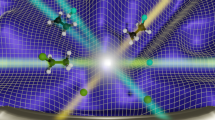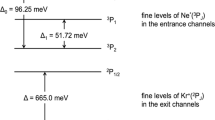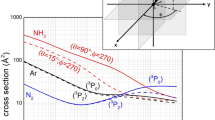Abstract
In addition to the nucleophile and solvent, the leaving group has a significant influence on SN2 nucleophilic substitution reactions. Its role is frequently discussed with respect to reactivity, but its influence on the reaction dynamics remains unclear. Here, we uncover the influence of the leaving group on the gas-phase dynamics of SN2 reactions in a combined approach of crossed-beam imaging and dynamics simulations. We have studied the reaction F− + CH3Cl and compared it to F− + CH3I. For the two leaving groups, Cl and I, we find very similar structures and energetics, but the dynamics show qualitatively different features. Simple scaling of the leaving group mass does not explain these differences. Instead, the relevant impact parameters for the reaction mechanisms are found to be crucial and the differences are attributed to the relative orientation of the approaching reactants. This effect occurs on short timescales and may also prevail in solution-phase conditions.
This is a preview of subscription content, access via your institution
Access options
Subscribe to this journal
Receive 12 print issues and online access
$259.00 per year
only $21.58 per issue
Buy this article
- Purchase on Springer Link
- Instant access to full article PDF
Prices may be subject to local taxes which are calculated during checkout




Similar content being viewed by others
References
Vollhardt, K. P. C. & Shore, N. E. Organic Chemistry: Structure and Function (W. H. Freeman, 2005).
Olmstead, W. N. & Brauman, J. I. Gas-phase nucleophilic displacement reactions. J. Am. Chem. Soc. 99, 4219–4228 (1977).
Shaik, S. S. The collage of SN2 reactivity patterns—a state correlation diagram model. Prog. Phys. Org. Chem. 15, 197–337 (1985).
Viggiano, A. A., Morris, R. A., Paschkewitz, J. S. & Paulson, J. F. Kinetics of the gas-phase reactions of chloride anion, Cl− with CH3Br and CD3Br: experimental evidence for nonstatistical behavior? J. Am. Chem. Soc. 114, 10477–10482 (1992).
Hase, W. L. Simulations of gas-phase chemical reactions: applications to SN2 nucleophilic substitution. Science 266, 998–1002 (1994).
Chabinyc, M. L., Craig, S. L., Regan, C. K. & Brauman, J. I. Gas-phase ionic reactions: dynamics and mechanism of nucleophilic displacements. Science 279, 1882–1886 (1998).
Laerdahl, J. K. & Uggerud, E. Gas phase nucleophilic substitution. Int. J. Mass Spectrom. Ion Phys. 214, 277–314 (2002).
Schmatz, S. Quantum dynamics of gas-phase SN2 reactions. ChemPhysChem 5, 600–617 (2004).
Mikosch, J. et al. Imaging nucleophilic substitution dynamics. Science 319, 183–186 (2008).
Bento, A. P. & Bickelhaupt, F. M. Nucleophilicity and leaving-group ability in frontside and backside SN2 reactions. J. Org. Chem. 73, 7290–7299 (2008).
Garver, J. M., Gronert, S. & Bierbaum, V. M. Experimental validation of the alpha-effect in the gas phase. J. Am. Chem. Soc. 133, 13894–13897 (2011).
Kretschmer, R., Schlangen, M. & Schwarz, H. Efficient and selective gas-phase monomethylation versus N–H bond activation of ammonia by bare Zn(CH3)+: atomic zinc as a leaving group in an SN2 reaction. Angew. Chem. Int. Ed. 50, 5387–5391 (2011).
Otto, R. et al. Single solvent molecules can affect the dynamics of substitution reactions. Nature Chem. 4, 534–538 (2012).
Xie, J. et al. Identification of atomic-level mechanisms for gas-phase X−+CH SN2 reactions by combined experiments and simulations. Acc. Chem. Res. 47, 2960–2969 (2014).
Fernández, I. & Bickelhaupt, F. M. The activation strain model and molecular orbital theory: understanding and designing chemical reactions. Chem. Soc. Rev. 43, 4953–4967 (2014).
Szabó, I. & Czakó, G. Revealing a double-inversion mechanism for the F−+CH3Cl SN2 reaction. Nature Commun. 6, 5972 (2015).
Thallmair, S., Kowalewski, M., Zauleck, J. P. P., Roos, M. K. & de Vivie-Riedle, R. Quantum dynamics of a photochemical bond cleavage influenced by the solvent environment: a dynamic continuum approach. J. Phys. Chem. Lett. 5, 3480–3485 (2014).
Orr-Ewing, A. J. Perspective: bimolecular chemical reaction dynamics in liquids. J. Chem. Phys. 140, 090901 (2014).
Garver, J. M. et al. A direct comparison of reactivity and mechanism in the gas phase and in solution. J. Am. Chem. Soc. 132, 3808–3814 (2010).
Liu, S., Hu, H. & Pedersen, L. G. Steric, quantum, and electrostatic effects on SN2 reaction barriers in gas phase. J. Phys. Chem. A 114, 5913–5918 (2010).
DeTuri, V. F., Hintz, P. A. & Ervin, K. M. Translational activation of the SN2 nucleophilic displacement reactions Cl− + CH3Cl (CD3Cl) → ClCH3 (ClCD3) + Cl−: a guided ion beam study. J. Phys. Chem. A 101, 5969–5986 (1997).
Anderson, J. S. M., Liu, Y., Thomson, J. W. & Ayers, P. W. Predicting the quality of leaving groups in organic chemistry: tests against experimental data. J. Mol. Struct. THEOCHEM 943, 168–177 (2010).
Jaramillo, P., Domingo, L. R. & Pérez, P. Towards an intrinsic nucleofugality scale: the leaving group (LG) ability in CH3LG model system. Chem. Phys. Lett. 420, 95–99 (2006).
Eppink, A. T. J. B. & Parker, D. H. Velocity map imaging of ions and electrons using electrostatic lenses: application in photoelectron and photofragment ion imaging of molecular oxygen. Rev. Sci. Instrum. 68, 3477 (1997).
Mikosch, J. et al. Indirect dynamics in a highly exoergic substitution reaction. J. Am. Chem. Soc. 135, 4250–4259 (2013).
Sun, R., Davda, C. J., Zhang, J. & Hase, W. L. Comparison of direct dynamics simulations with different electronic structure methods. F− + CH3I with MP2 and DFT/B97-1. Phys. Chem. Chem. Phys. 17, 2589–2597 (2015).
Angel, L. A. & Ervin, K. M. Dynamics of the gas-phase reactions of fluoride ions with chloromethane. J. Phys. Chem. A 105, 4042–4051 (2001).
Su, T., Wang, H. & Hase, W. L. Trajectory studies of SN2 nucleophilic substitution F− + CH3Cl → FCH3 + Cl−. J. Phys. Chem. A 102, 9819–9828 (1998).
Zhang, J. et al. F− + CH3I → FCH3 + I− Reaction dynamics. nontraditional atomistic mechanisms and formation of a hydrogen-bonded complex. J. Phys. Chem. Lett. 1, 2747–2752 (2010).
Xie, J. et al. Direct dynamics simulations of the product channels and atomistic mechanisms for the OH– + CH3I reaction. Comparison with experiment. J. Phys. Chem. A 117, 7162–7178 (2013).
Vanorden, S. L., Pope, R. M. & Buckner, S. W. Energy disposal in gas-phase nucleophilic displacement reactions. Org. Mass Spectrom. 26, 1003–1007 (1991).
Lide, D. R. (ed.) Handbook of Chemistry and Physics (CRC Press, 2003).
Su, T., Morris, R. A., Viggiano, A. A. & Paulson, J. F. Kinetic energy and temperature dependences for the reactions of fluoride with halogenated methanes: experiment and theory. J. Phys. Chem. 94, 8426–8430 (1990).
Wester, R. Velocity map imaging of ion–molecule reactions. Phys. Chem. Chem. Phys. 16, 396–405 (2014).
Szabó, I., Császár, A. G. & Czakó, G. Dynamics of the F− + CH3Cl → Cl− + CH3F SN2 reaction on a chemically accurate potential energy surface. Chem. Sci. 4, 4362 (2013).
Acknowledgements
This work is supported by the Austrian Science Fund (FWF), project P 25956-N20. E.C. acknowledges support from a DOC-Fellowship by the Austrian Academy of Sciences (ÖAW). G.C. was supported by the Scientific Research Fund of Hungary (OTKA, PD-111900) and the János Bolyai Research Scholarship of the Hungarian Academy of Sciences.
Author information
Authors and Affiliations
Contributions
M.S., E.C., A.K. and R.W. conceived the experiment. M.S., E.C., A.K. and M.K performed the measurements. M.S. analysed the data. I.S. and G.C. carried out the simulations. All authors discussed the results. A.K, M.S., E.C., J.M., G.C. and R.W. wrote the paper.
Corresponding authors
Ethics declarations
Competing interests
The authors declare no competing financial interests.
Rights and permissions
About this article
Cite this article
Stei, M., Carrascosa, E., Kainz, M. et al. Influence of the leaving group on the dynamics of a gas-phase SN2 reaction. Nature Chem 8, 151–156 (2016). https://doi.org/10.1038/nchem.2400
Received:
Accepted:
Published:
Issue Date:
DOI: https://doi.org/10.1038/nchem.2400
This article is cited by
-
Atomistic dynamics of elimination and nucleophilic substitution disentangled for the F− + CH3CH2Cl reaction
Nature Chemistry (2021)
-
Direct observation of a Feshbach resonance by coincidence detection of ions and electrons in Penning ionization collisions
Nature Communications (2020)
-
Grafting polysulfides into a functional N-halo compound for high-performance lithium—sulfur battery
Science China Materials (2020)
-
Dynamical barrier and isotope effects in the simplest substitution reaction via Walden inversion mechanism
Nature Communications (2017)
-
Imaging dynamic fingerprints of competing E2 and SN2 reactions
Nature Communications (2017)



